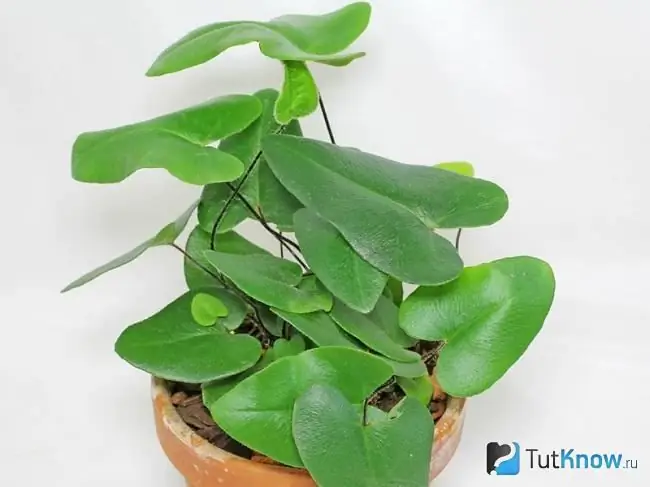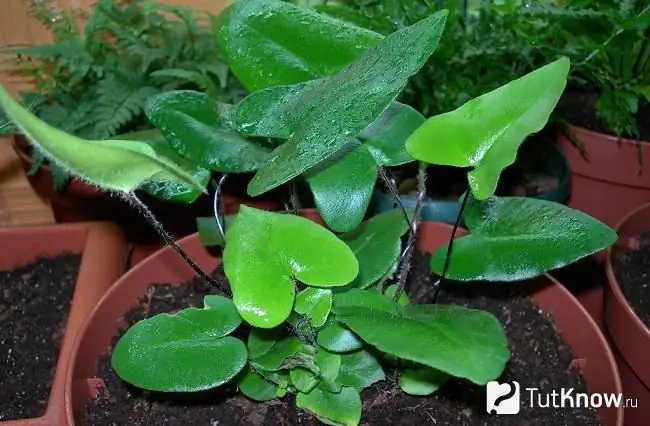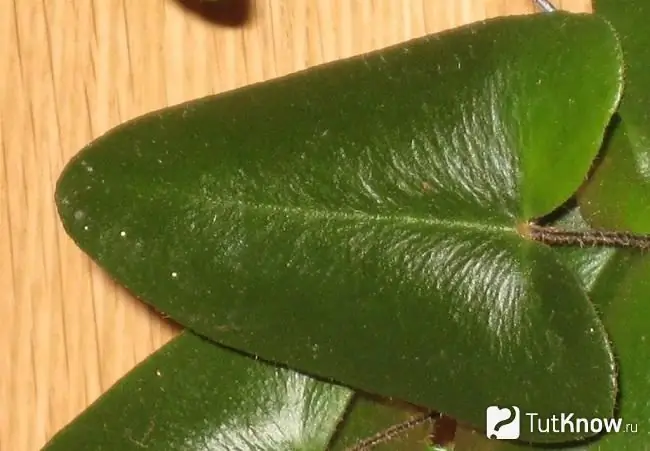The characteristic differences of the plant, recommendations for the home maintenance of chemionitis, breeding rules, the fight against possible difficulties (diseases and pests), facts for the curious, species. Hemionitis is a plant belonging to the Hemionitidaceae family, according to some sources, to the Adiantaceae family, according to others. But both that, and another family includes ferns. Native territories of its growth are in the lands of the northern regions of America (where there is a tropical climate), as well as regions of Vietnam, India, the Philippines, Laos and Sri Lanka. There are 8 varieties in this genus. However, the species H. aronikolistny (Hemionitis arifolia) and H. palmate (P. palmata), which are used as indoor crops, are very popular.
This green world was first described by Dutch botany professor Nicholas Laurens Burman (1734–1793), who specialized in ferns, algae and seed-forming flora and did much to illuminate the characteristics of such plants. This genus Hemionitis received its scientific name thanks to the translation of the Greek word "hmi-onoj", which meant as "sterile fern".
Hemionitis is a perennial plant that is completely different from its "brothers" in the family. Its height parameters are in the range of 25–40 cm. Because of the love for high humidity and small size, it is usually grown in florarium conditions. The plant has a creeping rhizome, the surface of which is covered with scales. Leaf plates, like many ferns, are divided into two types: fertile (those on which spores form) and sterile. If fronds (as the leaves of ferns are called) do not carry spores, then they are attached to petioles not larger than 10 cm in length, but have buds at the base of the leaf. Fertile leaves rise higher on petioles reaching a height of 25 cm. The petioles are painted dark brown or black, they are completely covered with pubescence of dark hairs.
The size of the leaves is rather large, they are close to 25 cm in length. Their surface is leathery, shiny, shimmering with gloss. The color of the foliage is a rich dark green color scheme. On the reverse side, the leaf has pubescence. The shape that the leaf plates take can be arrow-shaped, heart-shaped, or finger-lobed. At the top there is a sharpening or it has a rounded end. Because of this feature, hemionitis is also not very fern-like.
Sporangia (an organ that ferns, algae and fungi possess that produces spores) on the leaves are located along the veins on the back of the leaf. The presence of such an organ allows the plant to be ranked as ferns, despite the unusual appearance of the leaves. The pattern of the spores resembles a herringbone. Due to their reddish or rusty brown color, they are clearly visible on a green surface.
With the arrival of spring and throughout the summer period, new leaf plates are being formed in chemionitis, while the old ones begin to gradually dry out. It is curious that over time, the bud, which is near a sterile leaf (baby), if the growing conditions are favorable, will wake up and give life to a young plant. When it develops its own root processes, then such a "baby" will fall to the ground and successfully take root there. Because of this, such a fern is considered "viviparous".
Hemionitis also has another interesting property - in the process of its growth, it begins to secrete a special substance into the soil, which may not allow any of the other representatives of the flora to grow side by side, except for the fern itself. Therefore, it is recommended for home cultivation to use only individual flowerpots that have an individual stand for it.
The plant is not too easy to care for, and if the grower lacks experience, he can easily ruin hemionitis by violating the conditions described below.
Recommendations for home cultivation of hemionitis, care and watering

- Lighting and location selection. For this fern, diffused light is needed - a north window will do, shading is needed in an east or west location.
- Content temperature. In the spring and summer months, they try to keep the thermometer readings in the range of 23-28 units, while the temperature should be low at night. With the arrival of autumn, it is recommended to reduce heat indicators to 16 degrees.
- Air humidity when growing chemionitis, it should be maintained above 50% or more, however, it is known that this fern can successfully adapt to reduced performance. The pot with the plant can be installed in a deep tray, at the bottom of which wet expanded clay or peat is laid. But in order for hemionitis to feel comfortable, terrariums or aquariums are used. It is important that the humidity is high if the plant is kept in the winter with the heating devices on.
- Watering. It must be remembered that since the fern naturally grows on a moist substrate in tropical climates, the soil in the pot should never dry out. However, the bay and constant waterlogging will lead to decay of the root system of the hemionitis. It is also forbidden to dry the substrate, since leaf fronds will immediately begin to die off. With the arrival of the summer heat, watering is often carried out daily. In this case, it is necessary that the soil is completely saturated with moisture, and its residues come out through the drainage holes. After 10-15 minutes, remove the liquid from the pot holder. Between waterings, the soil from above can only dry out slightly. In winter, watering is reduced, especially when kept in cool conditions. Soft water with a temperature of 20-24 degrees is used for irrigation. You can use river water, collect rainwater, or use distilled, bottled water.
- Fertilizer for chemionitis it is necessary to make monthly during the period of growth activation, but it is possible and less often, carrying out fertilizing, diluted twice with mineral preparations. Fern responds well to organic products (for example, mullein). Fertilization is stopped during the winter months.
- Transplant and advice on soil selection. While hemionitis is still young, the pot is changed annually, but over time, such operations are only necessary as the root processes fill the entire pot or the size of the plant becomes too large. It is recommended to purchase clay pots that are small in height, this is due to the structure of the root system. It is imperative to lay a drainage layer at the bottom, and make small holes in the bottom to drain excess moisture after watering. For transplantation, you can use ready-made commercial compositions for ferns, which have sufficient looseness and permeability to water and air. If you wish, you can make up a substrate from peat and deciduous soil (humus), taken in equal parts. Chopped sphagnum moss and charcoal bushes are also added there.
- General advice for the care of chemionitis. It is important to remove old leaf fronds in a timely manner and regularly divide the overgrown bush. Dust from the leaves must be removed with a soft brush.
Breeding rules for hemionitis

Such an unusual fern can be propagated by dividing an overgrown bush, sowing spores or jigging "babies".
With the arrival of summer, if the mother hemionitis bush has grown strongly, then it can be divided into parts. It is necessary to remove the plant from the pot and use a sharpened knife to cut the root system into pieces, so that each division has a sufficient number of leaves and several points of growth. Then it is recommended to sprinkle the sections with activated charcoal or charcoal powder. Chamionitis parts are planted in separate pots, on the bottom of which a drainage layer and a suitable substrate are laid. At first, the delenki are covered with a plastic bag and shaded.
Reproduction using spores for a novice grower can be a difficult procedure and it does not always give a positive result. To do this, ripened spores located on the back of the sheet must be scraped off onto a piece of paper, put in a paper envelope and dried. Then you need a plastic deep container (container), preferably with a transparent lid. A brick is placed in it at the bottom, on the surface of which a layer of peat is poured and moistened with a spray bottle. Water is poured into the container so that its height is approximately 5 cm.
Spores are deposited on the peat surface, and the container is covered with a lid or a transparent plastic bag. During germination, the recommended water level in the container is constantly maintained, which is placed in a fairly shaded place. Temperature readings should be around 21 degrees.
After several months, a green moss coating can be seen on the surface of the peat, after some time the first leaves are formed. Only when the seedlings of hemionitis reach a height of 5 cm can they be planted.
It is also possible to plant small daughter formations (babies), which usually grow if conditions are favorable from the buds located at the base of sterile leaves or along their edge. When such babies grow a sufficient number of root processes, then in nature they themselves fall off the mother fern and take root in the substrate. They can be removed with hemionitis and planted in separate small pots.
Fight against possible difficulties (diseases and pests) in the home cultivation of hemionitis

Since the plant is quite difficult to care for, then with any even minor violation of the rules of maintenance, it begins to weaken. At the same time, the following harmful insects can affect it: spider mites, mealybugs, aphids, scale insects. If symptoms of pests are found, the foliage should be washed under warm streams of water (shower is desirable), and then wipe the leaf plates on both sides with an oil, soap or alcohol solution. However, this operation can be difficult, since some species have pubescence on both sides. Therefore, it is recommended to spray with insecticidal preparations of a wide spectrum of action.
You can list the following problems that arise when you violate the rules of care:
- wilting of the deciduous mass occurs due to waterlogging of the soil in the pot, a drop in temperature or too much drying of the earthy coma in the heat;
- the ends of the leaf plates begin to turn yellow and subsequently dry out if the humidity in the room where the chemionitis is kept is low;
- along the edge, the leaves curl and dry out with constant exposure to direct sunlight;
- the color of the foliage turns pale, takes on a yellow tint, if there is insufficient lighting.
Facts for the curious about chemionitis, photos

Plants that are commercially available are usually quite young. When buying, the first thing worth paying attention to (according to the advice of flower growers) is the health of a representative of the flora. It is necessary to carefully examine the fern, whether there are manifestations of the presence of harmful insects. When there are no visible symptoms, hemionitis is still "quarantined" after the purchase for the first time. After 14 days, if everything is in order, then the fern can be placed on the windowsill to other plants in a permanent place.
It is important to remember that although you can see stripes of sporangia and the presence of spores on the back of the foliage, their germination is rather difficult in the conditions of the rooms. Some species of this representative of the adianthus, for example, such as Hemionitis palmata, are grown in botanical gardens. They are practically not suitable for home cultivation, because they require rather humid air.
Curiously, the Hemionitis arifolia variety is used in Asian medicine to treat diabetes. Also, this fern has been medically evaluated for its hypoglycemic and antidiabetic properties in rats. Some of the extracts found in the plant were found to lower blood glucose levels in sugar-fed rats, but only a small amount of hypoglycemic activity was observed in overnight fasting. It is not known whether fern extracts can be used in humans. It is customary for healers to grind sterile leaves into a paste and mix with water, and then use it to treat joint pain or burns.
Fern species hemionitis

- Hemionitis arifolia is a small fern, which does not exceed 40 cm in length. Fertile leaves (spore-bearing) have an arrow-triangular shape. The foliage surface is shiny and glossy above, and there is slight pubescence on the back. Sterile fronds in the plant also differ in a triangular outline, but with a heart-shaped base. The size of the leaves in length is from 5 to 7 cm. The stem reaches a height of 15 to 25 cm. On the reverse side of the leaf, along the veins, sporangia, distinguished by a dark red color, are visible against a dark green background. They are located very densely. It is often possible to hear in places of natural growth, as this species is called "heart-shaped fern" or "tongue-shaped fern". And synonyms in Latin are Asplenium arifolium, Gymnogramma arifolia, Gymgogramma sagittata, Hemionitis cordata, Hemionitis cordifolia, Hemionitis sagittata, Hemionitis toxotis. Basically, its distribution falls on the lands of Laos, Sri Lanka, Vietnam and, possibly, the territories of China, Taiwan and other states located in the tropical part of Southeast Asia are included here. The plant can feel comfortable both on the soil surface and "settle" as an epiphyte on the trunks or branches of trees. This variety was first described in 1895.
- Hemionitis palmata in its external characteristics it is similar to the previous species, but its fronds, which have palmate-lobed outlines, serve as a striking difference. The shape of sterile leaf plates is trilobate or palm-shaped. Sporangia are distinguished by their reticular appearance and elongated contour, their color is brown. They are located along the veins. The petioles of spore-bearing wai (fertile) are almost twice as large as those of sterile foliage. Therefore, such leaves rise above the entire bush. This plant is great for terrarium conditions or a Vardian vessel. Its native places of growth are in the tropical forests of Central and South America. Does not differ in hardiness, preferring to grow in the shade and on damp and drained compost.
- Hemionitis pinnatifida is a plant that is distinguished by its pinnately-divided wai outlines. The native habitat is Central America. The family also includes less popular varieties: H. levyi, H. rufa, H. subcordata, H. tomentosa, H. x smithii.






